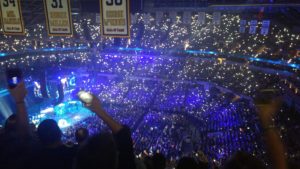There are some unifying, once-in-a-lifetime, bucket list moments that help melt away the anxiety, sadness and fear of uncertain times and national tragedies.

Garth Brooks performs in Indianapolis on Thursday night (Photo by Rebecca Patrick)
It might sound effusive, but being at the first Garth Brooks performance in Indianapolis on Thursday – his first in our city in 21 years – was one of those moments for me. And it certainly felt like the other thousands of attendees and even Brooks himself (who said on several occasions that he “needed this”) felt the same.
Without directly speaking of the largest mass shooting in American history, at a country music festival in Las Vegas on Sunday where 58 were gunned down and over 500 were injured, the tragedy loomed large in the arena. Brooks and his wife, award-winning musician Trisha Yearwood (who joined him on stage on two separate occasions), both wore black shirts with “for Vegas” across the front. Both mentioned needing a cheering crowd and the chance to entertain people through music and laughter and fun.
It was heightened security outside of Bankers Life Fieldhouse that served as our first, stark reminder that we were doing just what those other country music revelers were doing less than a week ago. There were armored vehicles and horseback mounted police out front, K-9 dogs both inside and out, many more officers than usual and long lines for security screenings.

Photo by Rebecca Patrick
Known for his goofy entertaining style, there was plenty of Garth Brooks just being Garth Brooks. He delighted the crowd with the “old stuff,” as well as his new single. And the end of the show was Brooks by himself on stage with an acoustic guitar, interacting with the crowd and taking song requests from poster board signs. It made a jam-packed arena of people feel like they were at an intimate show.
Brooks was also visibly emotional at times, during songs like “The River,” when the crowd turned on phone flashlights and filled the fieldhouse with sparkling lights. Or, near the end with “The Dance” and “Unanswered Prayers” and “New Way to Fly,” as the lyrics lend themselves to a beautiful and quiet introspection, particularly when everyone sings along.

Photo by Charlee Beasor
With five shows in four days in downtown Indianapolis, the economic impact of Brooks in town is tremendous. The show wrapped up just before midnight and there were plenty of hungry people spilling into nearby bars and restaurants. And Brooks notes publicly that adding shows when the original dates sell out quickly is his way of fighting back against ticket scalpers and bots. With tickets priced at $67, he ensures fans of all stripes can afford the chance to participate.
In the end, Brooks’ long-awaited return coupled with the horrifying events of Sunday still fresh in people’s minds turned this night into more than a concert. It served as an opportunity for Hoosiers to come together despite fear and sadness and disagreements over politics, sports or anything else. We sang and danced and screamed our hearts (and voices!) out, and Brooks was clearly grateful to be back on stage in Indianapolis to help him heal, too.

Garth Brooks and Trisha Yearwood perform together. (Photo by Rebecca Patrick)
If you’ve got tickets for his other shows, I hope the experience is similar for you. Tip: If you have a song you want to hear live, your best bet is to write it on a poster board and bring it along!
And we can’t forget football fans who also love country music. You might recall the last time Brooks played here. In March 1996, he wore a Colts’ Jim Harbaugh jersey and reminisced about the quarterback’s near miss at leading us to the Super Bowl. Now the football team intersects with Brooks again. The bronze statute for Colts legend Peyton Manning will be unveiled at 3 p.m. on Saturday – the same time Brooks is starting his third of five concerts.
Enjoy the shows!


 Dear technology,
Dear technology, As we prepare to close out 2013, what are the top travel trends for 2014? A report, based on actual booking data and travel agent survey, provides some answers.
As we prepare to close out 2013, what are the top travel trends for 2014? A report, based on actual booking data and travel agent survey, provides some answers. Like many states, Indiana wrestles with water supply issues and a viable statewide plan is desperately needed. However, our situation is not nearly as dire as it is for Nevada. Stateline documents how a water pact between Nevada and Utah, which was mandated in 2004 and tentatively agreed to in 2009, has now washed down the drain as Utah's governor poured cold water on the deal (so many water puns).
Like many states, Indiana wrestles with water supply issues and a viable statewide plan is desperately needed. However, our situation is not nearly as dire as it is for Nevada. Stateline documents how a water pact between Nevada and Utah, which was mandated in 2004 and tentatively agreed to in 2009, has now washed down the drain as Utah's governor poured cold water on the deal (so many water puns).
 On Saturday, November 5, I’ll toe the line at the
On Saturday, November 5, I’ll toe the line at the  Though children might shriek “Disneyland” when asked where they want to go on vacation, the “adult play land” of Las Vegas is the top choice for travelers in 2011, according to results from Travel Leaders’ 2011 Travel Trends Survey.
Though children might shriek “Disneyland” when asked where they want to go on vacation, the “adult play land” of Las Vegas is the top choice for travelers in 2011, according to results from Travel Leaders’ 2011 Travel Trends Survey. A
A